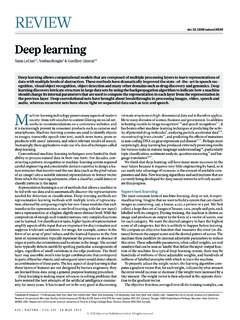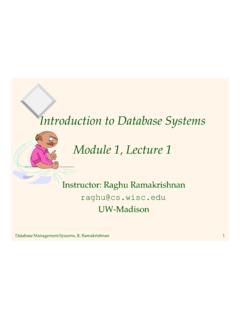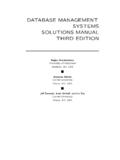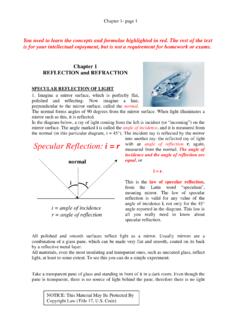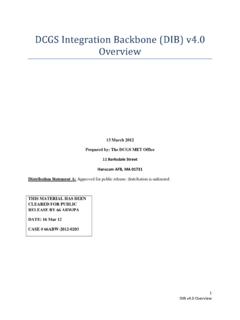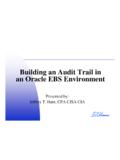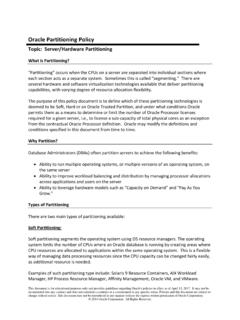Transcription of The Adaptive Lasso and Its Oracle Properties
1 The Adaptive Lasso and Its Oracle Properties Hui Z OU. The Lasso is a popular technique for simultaneous estimation and variable selection. Lasso variable selection has been shown to be consistent under certain conditions. In this work we derive a necessary condition for the Lasso variable selection to be consistent. Consequently, there exist certain scenarios where the Lasso is inconsistent for variable selection. We then propose a new version of the Lasso , called the Adaptive Lasso , where Adaptive weights are used for penalizing different coefficients in the 1 penalty. We show that the Adaptive Lasso enjoys the Oracle Properties ; namely, it performs as well as if the true underlying model were given in advance. Similar to the Lasso , the Adaptive Lasso is shown to be near-minimax optimal. Furthermore, the Adaptive Lasso can be solved by the same efficient algorithm for solving the Lasso . We also discuss the extension of the Adaptive Lasso in generalized linear models and show that the Oracle Properties still hold under mild regularity conditions.
2 As a byproduct of our theory, the nonnegative garotte is shown to be consistent for variable selection. KEY WORDS: Asymptotic normality; Lasso ; Minimax; Oracle inequality; Oracle procedure; Variable selection. 1. INTRODUCTION high variability and in addition is often trapped into a local op- timal solution rather than the global optimal solution. Further- There are two fundamental goals in statistical learning: en- more, these selection procedures ignore the stochastic errors or suring high prediction accuracy and discovering relevant pre- uncertainty in the variable selection stage (Fan and Li 2001;. dictive variables. Variable selection is particularly important Shen and Ye 2002). when the true underlying model has a sparse representation. The Lasso is a regularization technique for simultaneous esti- Identifying significant predictors will enhance the prediction mation and variable selection (Tibshirani 1996). The Lasso esti- performance of the fitted model.
3 Fan and Li (2006) gave a com- prehensive overview of feature selection and proposed a uni- mates are defined as 2. fied penalized likelihood framework to approach the problem p p . of variable selection. ( Lasso ) = arg min y xj j + | j |, (1).. Let us consider model estimation and variable selection in j=1 j=1. linear regression models. Suppose that y = (y1 , .. , yn )T is where is a nonnegative regularization parameter. The sec- the response vector and xj = (x1j , .. , xnj )T , j = 1, .. , p, are ond term in (1) is the so-called 1 penalty, which is crucial the linearly independent predictors. Let X = [x1 , .. , xp ] be for the success of the Lasso . The 1 penalization approach is the predictor matrix. We assume that E[y|x] = 1 x1 + + also called basis pursuit in signal processing (Chen, Donoho, p xp . Without loss of generality, we assume that the data are and Saunders 2001). The Lasso continuously shrinks the co- centered, so the intercept is not included in the regression func- efficients toward 0 as increases, and some coefficients are tion.
4 Let A = { j : j = 0} and further assume that |A| = p0 < p. shrunk to exact 0 if is sufficiently large. Moreover, contin- Thus the true model depends only on a subset of the predictors. uous shrinkage often improves the prediction accuracy due to . Denote by ( ) the coefficient estimator produced by a fitting the bias variance trade-off. The Lasso is supported by much the- procedure . Using the language of Fan and Li (2001), we call oretical work. Donoho, Johnstone, Kerkyacharian, and Picard an Oracle procedure if ( ) (asymptotically) has the following (1995) proved the near-minimax optimality of soft threshold- Oracle Properties : ing (the Lasso shrinkage with orthogonal predictors). It also Identifies the right subset model, { j : j = 0} = A has been shown that the 1 approach is able to discover the right sparse representation of the model under certain condi- Has the optimal estimation rate, n( ( ) A A ) d tions (Donoho and Huo 2002; Donoho and Elad 2002; Donoho N(0, ), where is the covariance matrix knowing the true subset model.)
5 2004). Meinshausen and B hlmann (2004) showed that vari- able selection with the Lasso can be consistent if the underlying It has been argued (Fan and Li 2001; Fan and Peng 2004) that model satisfies some conditions. a good procedure should have these Oracle Properties . How- It seems safe to conclude that the Lasso is an Oracle pro- ever, some extra conditions besides the Oracle Properties , such cedure for simultaneously achieving consistent variable selec- as continuous shrinkage, are also required in an optimal proce- tion and optimal estimation (prediction). However, there are dure. also solid arguments against the Lasso Oracle statement. Fan Ordinary least squares (OLS) gives nonzero estimates to all and Li (2001) studied a class of penalization methods includ- coefficients. Traditionally, statisticians use best-subset selection ing the Lasso . They showed that the Lasso can perform auto- to select significant variables, but this procedure has two fun- matic variable selection because the 1 penalty is singular at damental limitations.
6 First, when the number of predictors is the origin. On the other hand, the Lasso shrinkage produces large, it is computationally infeasible to do subset selection. biased estimates for the large coefficients, and thus it could Second, subset selection is extremely variable because of its in- be suboptimal in terms of estimation risk. Fan and Li conjec- herent discreteness (Breiman 1995; Fan and Li 2001). Stepwise tured that the Oracle Properties do not hold for the Lasso . They selection is often used as a computational surrogate to subset also proposed a smoothly clipped absolute deviation (SCAD). selection; nevertheless, stepwise selection still suffers from the penalty for variable selection and proved its Oracle Properties . Hui Zou is Assistant Professor of Statistics, School of Statistics, University 2006 American Statistical Association of Minnesota, Minneapolis, MN 55455 (E-mail: The au- Journal of the American Statistical Association thor thanks an associate editor and three referees for their helpful comments December 2006, Vol.)
7 101, No. 476, Theory and Methods and suggestions. Sincere thanks also go to a co-editor for his encouragement. DOI 1418. Zou: The Adaptive Lasso 1419. Meinshausen and B hlmann (2004) also showed the conflict Without loss of generality, assume that A = {1, 2, .. , p0 }. Let of optimal prediction and consistent variable selection in the . C11 C12. Lasso . They proved that the optimal for prediction gives in- C= , C21 C22. consistent variable selection results; in fact, many noise features are included in the predictive model. This conflict can be easily where C11 is a p0 p0 matrix. understood by considering an orthogonal design model (Leng, We consider the Lasso estimates, (n) , Lin, and Wahba 2004). 2. p . p . Whether the Lasso is an Oracle procedure is an important (n) = arg min y xj j + n | j |, (2). question demanding a definite answer, because the Lasso has . j=1 j=1. been used widely in practice. In this article we attempt to pro- where n varies with n.
8 Let An = { j : j = 0}. The Lasso vari- (n). vide an answer. In particular, we are interested in whether the 1 penalty could produce an Oracle procedure and, if so, how. able selection is consistent if and only if limn P(An = A) = 1. We consider the asymptotic setup where in (1) varies with n (the sample size). We first show that the underlying model must Lemma 1. If n /n 0 0, then (n) p arg min V1 , satisfy a nontrivial condition if the Lasso variable selection is where consistent. Consequently, there are scenarios in which the Lasso . p selection cannot be consistent. To fix this problem, we then pro- V1 (u) = (u )T C(u ) + 0 |uj |. pose a new version of the Lasso , the Adaptive Lasso , in which j=1. Adaptive weights are used for penalizing different coefficients . Lemma 2. If n / n 0 0, then n( (n) ) d in the 1 penalty. We show that the Adaptive Lasso enjoys the arg min(V2 ), where Oracle Properties . We also prove the near-minimax optimality of the Adaptive Lasso shrinkage using the language of Donoho V2 (u) = 2uT W + uT Cu and Johnstone (1994).
9 The Adaptive Lasso is essentially a con- . p . vex optimization problem with an 1 constraint. Therefore, the + 0 uj sgn( j )I( j = 0) + |uj |I( j = 0) , Adaptive Lasso can be solved by the same efficient algorithm j=1. for solving the Lasso . Our results show that the 1 penalty is at least as competitive as other concave Oracle penalties and also and W has a N(0, 2 C) distribution. is computationally more attractive. We consider this article to These two lemmas are quoted from Knight and Fu (2000). provide positive evidence supporting the use of the 1 penalty From an estimation standpoint, Lemma 2 is more interesting, in statistical learning and modeling. because it shows that the Lasso estimate is root-n consistent. The nonnegative garotte (Breiman 1995) is another popu- In Lemma 1, only 0 = 0 guarantees estimation consistency. lar variable selection method. We establish a close relation be- However, when considering the asymptotic behavior of variable tween the nonnegative garotte and a special case of the Adaptive .
10 Selection, Lemma 2 actually implies that when n = O( n ), Lasso , which we use to prove consistency of the nonnegative An basically cannot be A with a positive probability. garotte selection.. The rest of the article is organized as follows. In Section 2 we Proposition 1. If n / n 0 0, then lim supn P(An =. derive the necessary condition for the consistency of the Lasso A) c < 1, where c is a constant depending on the true model. variable selection. We give concrete examples to show when the Based on Proposition 1, it seems interesting to study the as- Lasso fails to be consistent in variable selection. We define the ymptotic behavior of (n) when 0 = , which amounts to Adaptive Lasso in Section 3, and then prove its statistical prop- considering the case where n /n 0 and n / n . We erties. We also show that the nonnegative garotte is consistent provide the following asymptotic result. for variable selection. We apply the LARS algorithm (Efron.)
